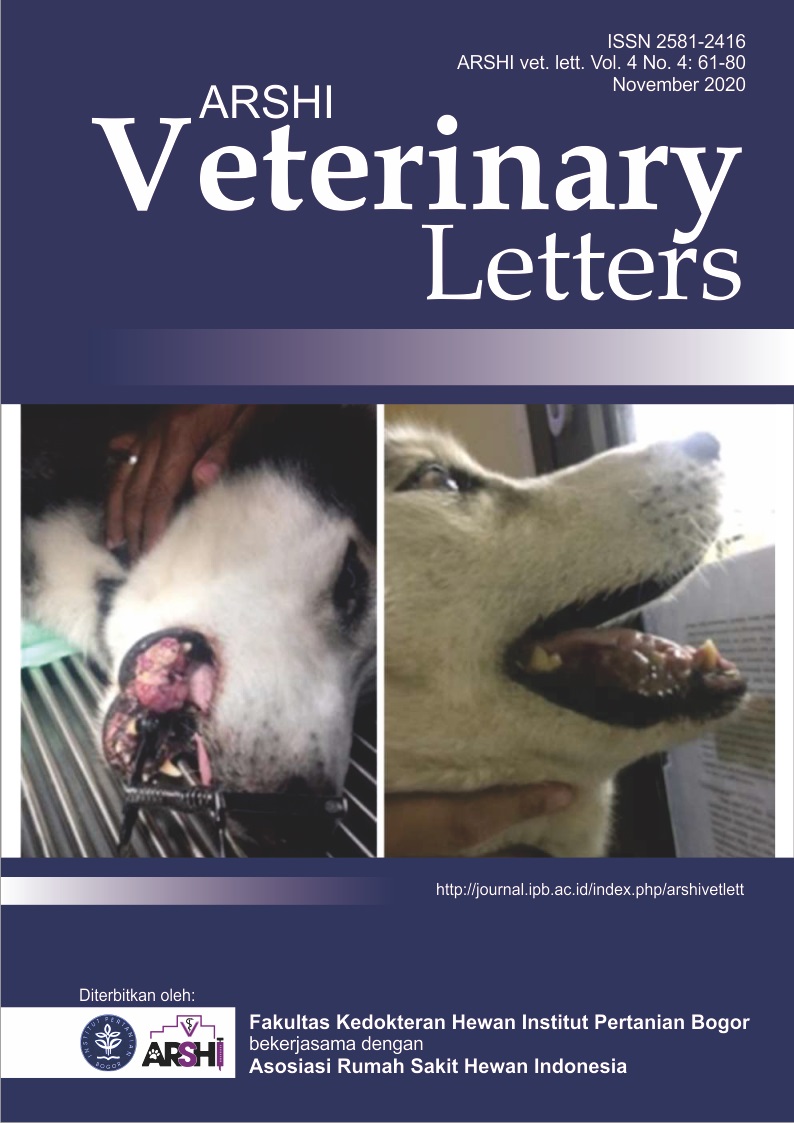The treatment of vaginal prolapse in a non-pregnant cow
Abstract
Vaginal prolapse generally occur in third trimester of pregnant cows. Vaginal prolapse not only occurs in pregnant cows, but can also in non-pregnant cows. This paper reported a vaginal prolapse occurred in non-pregnant cow after three months of parturition. The clinical sign was fever, increased respiratory rate, and the vaginal mucosa appears to be protruding from the vulva. Treatment is carried out by cleaning the vaginal mucosa using water and povidone iodine 2%, manual vaginal reposition. Administration of drugs such as antibiotic, antiinflammation, and multivitamin were given to the cow intramuscularly.
Downloads
References
Ennen S, Kloss S, Scheiner-Bobis G, Failing K, Wehrend A. 2011. Histological, hormonal and biomolecular analysis of the pathogenesis of ovine Prolapsus vaginae ante partum. Theri-ogenology, 75(2): 212-219.
Hasan T, Azizunnesa, Parvez MA, Paul P, Akter S, Faruk MO, Hossain, D. 2017. Correction and management of vaginal pro-lapse in a cow by Buhner’s technique. Research Journal for Veterinary Practitioners. 5 (1): 1-4.
Kumar A, Saxena A, Anand M, Girjesh Upmanyu G. 2018. Geni-tal prolapse in bovine and its management. International Jour-nal of Science, Environment and Technology. 7 (4): 1435 – 1439.
Miesner MD, Anderson DE. 2008. Management of uterine and vaginal prolapse in the bovine. Veterinary Clinics of North America: Food Animal Practice. 24 (2): 409-419.
Plumb DC. 2008. Plumb’s Veterinary Drug Handbook Sixth Edi-tion. Wisconsin: PharmaVet Inc.
Widodo E. 2015. Prolaps vagina pada sapi potong. Buletin La-boratorium Veteriner. 15 (2): 7-10.
Yin BA, Bari F, Ulum MF. 2018. Penanganan prolaps vagina pada sapi perah. ARSHI Veterinary Letters. 2 (3): 51-52.
Yotov S, Atanasov A, Atonov A, Karadaev M. 2013. Post oestral vaginal prolapse in a non-pregnant heifer (a case report). Trakia Journal of Science. 11 (1): 95-101.
Copyright (c) 2020 CC-BY-SA

This work is licensed under a Creative Commons Attribution-ShareAlike 4.0 International License.
Authors who publish with this journal agree to the following terms:
1. Authors retain copyright and grant the journal right of first publication with the work simultaneously licensed under a Creative Commons Attribution License that allows others to share the work with an acknowledgement of the work's authorship and initial publication in this journal.
2. Authors are able to enter into separate, additional contractual arrangements for the non-exclusive distribution of the journal's published version of the work (e.g., post it to an institutional repository or publish it in a book), with an acknowledgement of its initial publication in this journal.
3. Authors are permitted and encouraged to post their work online (e.g., in institutional repositories or on their website) prior to and during the submission process, as it can lead to productive exchanges, as well as earlier and greater citation of published work (See The Effect of Open Access).


.jpg)















